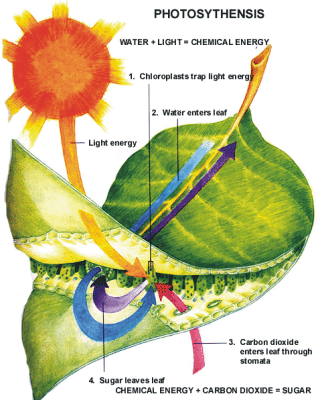Photosynthesis
is the process in which light energy is converted into chemical energy.
Using the energy of light, carbohydrates such as sugars are synthesised
from carbon dioxide and water.
The name photosynthesis is derived from the Greek words, photo for ‘light’ and synthesis
meaning ‘putting together’. Oxygen is also released, as a waste
product. Light is the major factor for photosynthesis to take place and
by doing this experiment we need to prove that light is necessary for
photosynthesis.
The Process of Photosynthesis
The process of photosynthesis occurs when green plants use the energy of light to convert carbon dioxide (CO2) and water (H2O)
into carbohydrates. Light energy is absorbed by chlorophyll, a
photosynthetic pigment of the plant, while air containing carbon dioxide
and oxygen enters the plant through the leaf stomata. An extremely
important by-product of photosynthesis is oxygen, on which most
organisms depend.
Glucose, a carbohydrate processed during
photosynthesis, is mostly used by plants as an energy source to build
leaves, flowers, fruits, and seeds. Molecules of glucose later combine
with each other to form more complex carbohydrates such as starch and
cellulose. The cellulose is the structural material used in plant cell
walls. Photosynthesis provides the basic energy source for virtually all
organisms.
We can express the overall reaction of photosynthesis as:
Where does Photosynthesis occur?
Photosynthesis takes place primarily in
leaves and little to none occurs in stems. It takes place within
specialised cell structures called chloroplasts. A leaf has a petiole or
the stalk and a lamina, the flat portion of the leaf. As its area is
broad, the lamina helps in the absorption of sunlight and carbon dioxide
during photosynthesis. Photosynthesis takes place in the chloroplasts
that have chlorophyll present in them. It is the chlorophyll that
absorbs light energy from the sun. There are tiny pores called stomata
that function as roadways for carbon dioxide to enter and oxygen to
leave the plant.
Role of the colour of light during Photosynthesis
Did you know that the colour of light plays
an important role during photosynthesis? Yes, it does. Plants use only
certain colours from light for the process of photosynthesis. The
chlorophyll absorbs blue, red and violet light rays. Photosynthesis
occurs more in blue and red light rays and less, or not at all, in green
light rays.
The light that is absorbed the best is
blue, so this shows the highest rate of photosynthesis, after which
comes red light. Green light cannot be absorbed by the plant, and thus
cannot be used for photosynthesis. Chlorophyll looks green because it
absorbs red and blue light, making these colours unavailable to be seen
by our eyes. It is the green light which is not absorbed that finally
reaches our eyes, making the chlorophyll appear green















